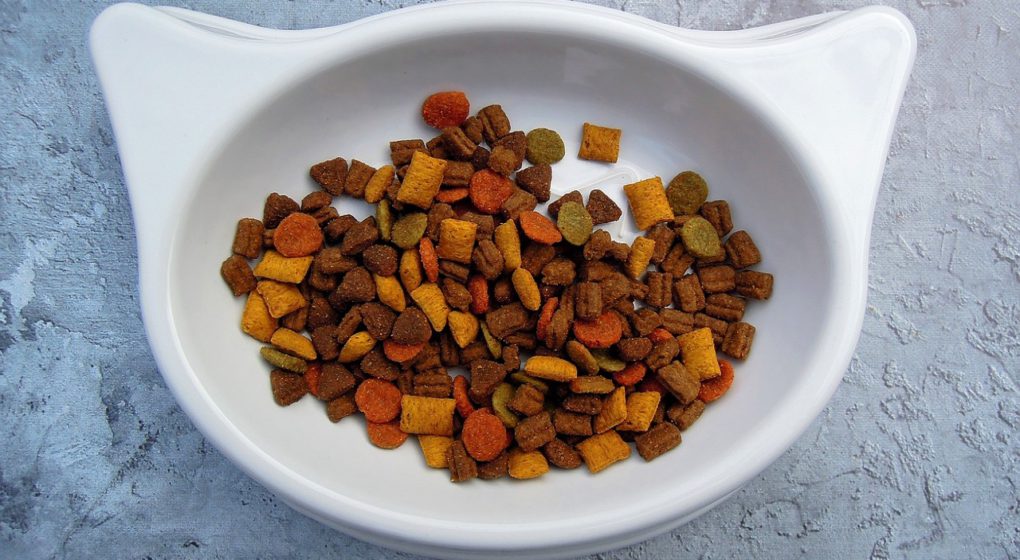
Feeding your cat the right food can make a huge difference in their quality of life, particularly from a health perspective. A good diet is a key lynchpin in good overall health and helps lead to a long and fulfilling life full of walking on humans while they sleep and helping them type on the laptop. That being said, finding the best food can be extremely difficult, especially when there’s so much debate raging over what is considered good food versus not.
I spent hours and hours digging through site after site and looking at food labels to pull together a summary of what you need to know about choosing the right food for your cat. But before we get into the dry vs wet cat food debate, let’s take a look at what key things you should understand to make a decision on what to feed your feline friend in general.
Where’s the Protein?
Cats are obligate carnivores. This basically means they can’t live without meat in their diet because specific nutrients they need simply aren’t available in plants. While the form of meat can range from beef to poultry to fish and everything in between, cats do require a source of meat to maintain a healthy diet. This doesn’t mean a cat cannot eat things like peas, or potatoes or rice, it just means that they can’t survive solely on a plant based diet.
To build protein, cats need to get an adequate supply of 11 different amino acids that their body can’t naturally produce. Without getting into the technicalities of it, there are some 23 amino acids that are used to build all protein and cats can only naturally produce 12 of them. This means they have to get the other 11 from their diet otherwise health issues ensue.
The health issues can be very serious and even result in the death of your cat, so do pay close attention to the amino acid contents. If you’d like to read more on the necessary amino acids and why they are so important checkout this article from PetMD that describes it in detail.
Cats Aren’t So Good at Drinking Water
Probably the largest source of debate on the wet vs dry food topic comes from the amount of water a cat should be drinking. Cats in general don’t naturally drink a lot of water, especially still water. Cats have all sorts of quirks when it comes to water. Some only drink from tall glasses, some from short, some from a dripping tap etc. What’s important to note is most cats don’t drink enough water to maintain proper hydration.
This is one of the key arguments driving people to lean toward only feeding cats wet food. Wet food comes with a heck of a lot more moisture than dry food. No surprise given the name. This basically helps make up the balance of the water your cat isn’t drinking on her own and mimics how a cat would get moisture in the wild when she hunts.
Hydration is very important for your cat, hence the surge in cat water fountains all over the market today. The key thing to note though is that most cats will continue to eat dry food even if you pour a tablespoon or two of water over the food to saturate it and help balance out the difference wet food would normally contain.
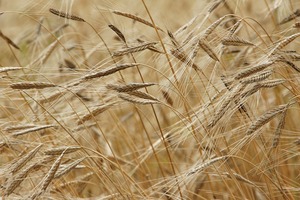 Why the Strain to Avoid the Grain?
Why the Strain to Avoid the Grain?
Just like in human food, there’s a lot of debate these days on whether or not your cat should be eating grain. A lot of pet food includes grain, which is basically a boat load of carbohydrates. While many people argue that carbohydrates are bad for your cat, there are an equal number indicating carbs are fine for your cat.
This is one of the biggest sources of controversy when it comes to dry food for cats today though. Dry food generally has more carbohydrates than wet food. Many people believe that cats should be fed a diet that maximizes proteins and removes as many carbs as possible because in the wild cats would consume a minimal amount of carbs.
If you do decide that you don’t want your cat eating carbs then be sure to check your food labels closely because the Grain Free label doesn’t mean carbohydrate free. Carbs come from a ton of sources, but one of the most common you’ll find in cat food is potatoes. Potatoes are one of those foods you probably want to avoid because they tend to cause a huge spike in blood sugar levels and spiking blood sugar levels can eventually lead to diabetes.
What’s In a Name?
Every tin or bag of cat food comes with a label, and that label contains a name. So what does that name mean to you as a consumer? You might be surprised to find this out, but there are guidelines that dictate how these labels are made up. The Association of American Feed Control Officials (AAFCO) established guidelines that regulate what must be included on pet food labels. This includes what those companies can include and what they can’t include on the labels. Let’s take a look at the key takeaways:
- If the food is advertised to contain a single ingredient or a combination of ingredients, it must contain at least 95% of that ingredient or combination of ingredients, not including added water. If the label says it is made of duck, then duck must make up 95%. If the claim is venison and bison, then the food must be made up of 95% venison and bison.
- Labels with names like duck dinner, duck platter, duck entrée must contain at least 25% of the named ingredient.
- Labels that indicate a food comes “with” an ingredient like “with cheese” must contain at least 3% of the named ingredient.
- The AAFCO also allows pet food producers to include a statement of ‘Nutritional Adequacy’ on their food if it includes the 11 amino acids I referred to above, this is definitely worth looking out for! See this screenshot to know what to look out for:

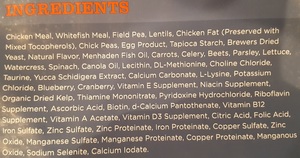 What About the Ingredients List?
What About the Ingredients List?
Food ingredients are listed in decreasing order according to weight, so you’re looking for something that is mostly meat. This means you want something that has meat listed as the first ingredient if not the first few ingredients depending on the combination in the formula. This is especially true in dry food. You probably want to avoid some more generic terms like ‘meat-meal’ or ‘ocean fish’ because it isn’t really clear what is in them, but something like chicken-meal or beef-meal is acceptable and worth considering because it isn’t a mystery meat.
What Are Key Formulas to Avoid?
- Dry foods without meat in the top 5 ingredients (wet foods often have water or broth as one of the top ingredients)
- Foods without any specific meat on the label (for example ‘meat-meal’ or ‘ocean-fish’)
- Foods that include preservatives & artificial ingredients, in particular: BHA, BHT, Caramel Color, Ethoxyquin, Sodium Nitrite, Vitamin K3
- Foods that include unidentified meat by-products, meat-meal, ocean fish, sugar, carrageenan, garlic, rendered fat, soybeans, sugar and xanthan
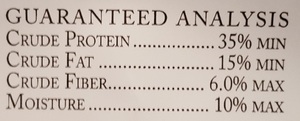 Nutrient Analysis
Nutrient Analysis
Who is ready for some math?!? Probably scared you a bit there, but don’t worry, it is simple stuff. Most cat food will now carry a guaranteed analysis on the label. This will basically tell you what % of crude protein, crude fat, crude fiber etc. are in the food. Note that the bare minimums recommended by the AAFCO for your typical adult cat is 26% protein.
If your cat is a growing (a kitten) or happens to be pregnant then you’ll want to aim for a minimum of 30% protein. This is just one more piece of the puzzle that can help you make the call on whether or not a specific can or bag of food is right for your cat.
Do I Try Wet or Dry?
Now for the real debate. Do I feed my cat only wet food, only dry food, or both? The battle lines have already been drawn on this subject and most people have an opinion they will vehemently defend even though they likely have little scientific proof to back their point of view up. Most websites are driven by anecdotal proof from ‘My cat got sick, my cat got healthy’ type stories which they than extrapolate into meaning it should apply to every cat.
Some experts believe that canned food is healthier than dry food and some believe the exact opposite. Others argue that cats do well on both types of food and a pet owner should be able to choose what is most convenient. And in some cases you just have to use whatever your cat will eat. Let’s take a look at a few of the biggest arguments though:
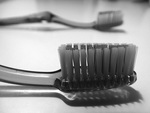 Plaque buildup is commonly mentioned as a key drawback of dry food. This is further confused by the mostly debunked argument that dry food helps remove plaque as the teeth puncture the food. Most people, vets included, will tell you that cats simply swallow dry food without chewing it. The simple fact is though, both wet and dry food will cause plaque to build up on your cat’s teeth. If this is something you’re seriously concerned about you should be brushing your cat’s teeth on a consistent basis and ensuring they get a dental checkup yearly.
Plaque buildup is commonly mentioned as a key drawback of dry food. This is further confused by the mostly debunked argument that dry food helps remove plaque as the teeth puncture the food. Most people, vets included, will tell you that cats simply swallow dry food without chewing it. The simple fact is though, both wet and dry food will cause plaque to build up on your cat’s teeth. If this is something you’re seriously concerned about you should be brushing your cat’s teeth on a consistent basis and ensuring they get a dental checkup yearly.- Wet food is often quoted as having more protein than dry food and thus better for your cat. When the math is done though and both are compared on an even scale there are high protein dry and wet foods, it is just a matter of choosing the right one. Check out this calculator created by the Feline Nutrition Awareness Effort (FNAE) that will help you convert both wet food and dry food into a comparable form.
- While canned food does by default contain more moisture and mimics a cat eating in the wild more accurately than dry food, the moisture argument can typically be resolved by providing cats a ready source of water or mixing a bit into their dry food.
- Dry food diets have been shown to increase the risk of urinary tract infections and issues within felines because with dry food only diets cats simply don’t tend to drink enough water which can make it harder for the kidneys to function, or so the theory goes.
- Wet food on the other hand has been shown to be linked to more thyroid problems in cats than dry food diets have. So while wet food may help balance out the kidneys it can have other negative impacts.
So What’s the Verdict?
 The most common answer I’ve heard is that both wet and dry food are fine so long as you’re choosing a high quality food and ensuring your cat is getting sufficient water. This means if your cat doesn’t drink enough water on her own that you’ll need to work to supplement their diet with sufficient water.
The most common answer I’ve heard is that both wet and dry food are fine so long as you’re choosing a high quality food and ensuring your cat is getting sufficient water. This means if your cat doesn’t drink enough water on her own that you’ll need to work to supplement their diet with sufficient water.
Many vets aren’t interested in providing a hard line answer on wet food versus dry food. This is mostly because there isn’t sufficient scientific evidence to back up either side yet. They instead encourage you to focus on what works with your cat and adjust their diet as necessary to ensure they thrive. Check out this article from Dr. Eric Barchas for more information.
I’ve had discussions with Beast and Lexi’s vet and he has agreed that a combination of wet and dry is fine. I’ve also spoken with numerous other cat owners that have had their vets second this point of view. We’ve all witnessed cats on both wet and dry or combination diets live long and wonderful lives. I feed my cats a combination of wet and dry food every day, I’ll freely admit they tend to eat more of the wet food than the dry food. But, they also do enjoy the dry food. I can see them eat it and while most dry food is too small to force a cat to chew, mine seem to really enjoy chewing and crunching their larger bits of dry food.
No matter which food you decide on you can use this quick process to help you determine if you’re choosing healthy food for your cat. Click for a full size image.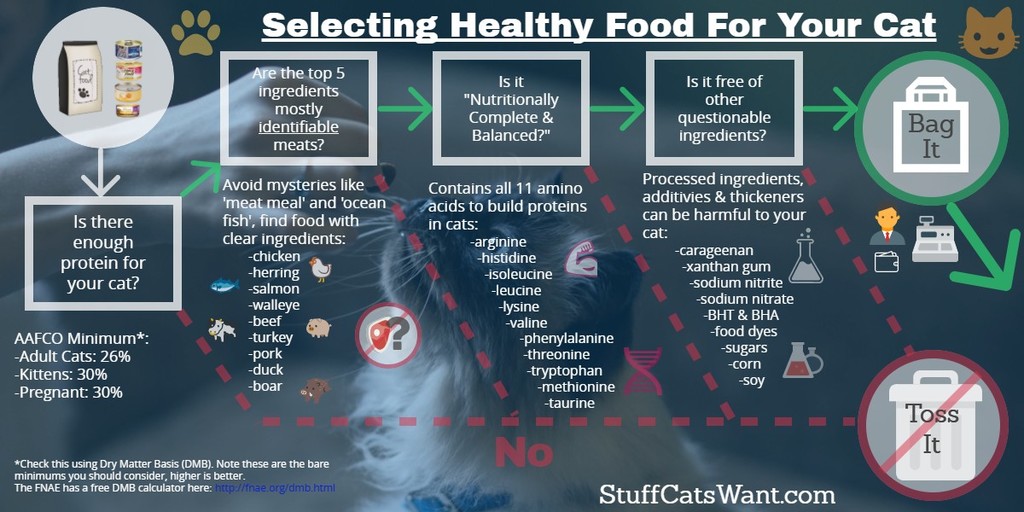
I’ll soon be posting my top 5 recommended dry and wet foods, so check back shortly for more information on some great options for either preference!
Is there Anything Else I Should Consider?
Each brand is going to get their ingredients from a different source and they are going to conduct quality control in different ways. The AAFCO does not provide any requirements for pet food producers in this regard so you might want to dig into it yourself. Some websites will provide the information, for example ACANA and Fromm both provide details on where their food is produced and whether or not it can be traced back to its source ingredients. You can always call or email an individual company for more information if you feel you need it more in depth information.
Even with a high quality well prepared diet your cat might still find itself chewing on other things in the house, like houseplants. If you see this happening you might want to provide your cat some cat grass as a treat. Check out my post here on how to grow your own cat grass.
What if I Still Can’t Decide?
If you’re still stuck, speak with your veterinarian about the best choices for your individual cat. Be sure to come armed with your information and with a good set of questions, don’t just ask the generic ‘Which is better?’ question. Every cat is different and every cat has different needs. Coming with a good background and specific questions will help your vet help you take into account your cats specific situation.
If you’re looking for even more information be sure to visit the following resources:
- Reviews.com – Great review of good dry food.
- PetMD – Great information on calculating nutrient content.
- CatInfo.org – A site dedicated to wet food only diets.
- CatNutrition.org – A site dedicated to raw cat food.
One thing I will call out is that I have not found a single website or article that indicates you should feed your cat only dry food. Given this it probably makes sense to use a combination of wet and dry at the least. But again, I’m not a veterinarian and you should always discuss with your vet before you make any specific decisions regarding your pet’s diet.
If you have any other thoughts on the what to feed your cat please leave a comment below or send me an email at Craig@StuffCatsWant.com so I can update this article or respond in kind.
